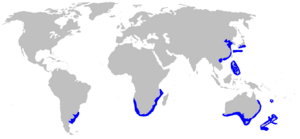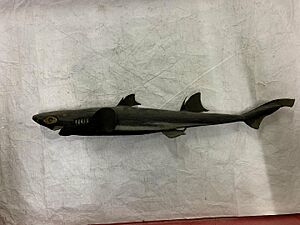Blackbelly lanternshark facts for kids
Quick facts for kids Blackbelly lanternshark |
|
|---|---|
 |
|
| Drawing by Dr Tony Ayling | |
| Conservation status | |
| Scientific classification | |
| Genus: |
Etmopterus
|
| Species: |
lucifer
|
 |
|
| Range of the blackbelly lanternshark (in blue) | |
The blackbelly lanternshark (also called the lucifer shark) is a small shark. Its scientific name is Etmopterus lucifer. It belongs to the family Etmopteridae. These sharks live deep in the ocean, between 150 and 1,250 meters down. This area is known as the mesopelagic zone.
Blackbelly lanternsharks are found in tropical and temperate seas worldwide. They can grow up to 47 centimeters (about 18.5 inches) long. They eat small ocean creatures like cephalopods (squids), fish, and crustaceans. These sharks are special because they can glow in the dark! They use tiny light-producing organs on their bellies. Scientists think they give birth to live young, rather than laying eggs.
Where They Live
The blackbelly lanternshark is common in the deep waters around New Zealand. They are often found on the south Chatham Rise. The most common depth for them is around 500 meters (about 1,640 feet).
These sharks prefer shallower, more southern parts of the deep ocean. Between 1992 and 2010, more of these sharks were seen along the east coast of New Zealand's North Island. When fishing boats catch other deep-sea fish, blackbelly lanternsharks are often caught by accident.
About Their Body
The blackbelly lanternshark has a thin body. It is brown on top and black on the bottom. It has more sensory pores on its belly than on its back. These pores help the shark sense prey from above.
It also has black marks near its belly fins and at the base of its tail fin. The shark has two fins on its back, with the second one being larger. Its tail fin is quite long.
Along its sides, from nose to tail, are rows of hook-shaped denticles. These are like tiny teeth on its skin. The lower jaw has 29 to 39 teeth, each with one point. The upper jaw has 21 to 26 teeth, each with up to three points. Their teeth are about 2 millimeters long.
The largest blackbelly lanternshark found was about 47 cm long. Males are usually 29 to 42 cm long. Females are 34 cm or longer.
This shark has a wide nose area called a rostrum. It has large eyes, which help it see in the dim deep-sea light. A clear area in its upper eye might help it spot camouflaged prey. Special cells in its eyes help it detect glowing marks from other sharks.
How They Glow
Three shark families are known to glow in the dark: Etmopteridae, Dalatiidae, and Somniosidae. Blackbelly lanternsharks, like other glowing sharks, have tiny light-producing organs called photophores.
Each photophore has cells that make light. It also has a lens and a special iris-like structure. This structure can open and close to let light out. Photophores are all over the shark's body, but they are much denser on its belly. They point downwards.
Scientists believe these sharks glow to hide themselves. When seen from below, their glowing bellies help them blend in with the faint sunlight from above. This camouflage protects them from predators deeper in the ocean.
Some glowing marks on the shark's sides might help them recognize each other. These marks could be a way for them to communicate.
The glowing of blackbelly lanternsharks can be controlled by hormones. Hormones like melatonin can make them glow more. Other hormones can make them glow less. Scientists are still studying exactly how these sharks produce their light.
What They Eat
Blackbelly lanternsharks are thought to give birth to live young. Their diet usually includes squids and lanternfishes (myctophids). However, what they eat can change a little depending on where they live.
Sharks near Australia also eat crustaceans. Those in Japan might eat tiny shrimp-like creatures called euphausiids. In Southern Africa, they prefer to hunt pelagic (open-ocean) cephalopods.
Scientists think blackbelly lanternsharks use their glowing photophores to attract prey. They also have many special sensors called Ampullae of Lorenzini. These sensors help them detect the electrical fields of other animals. This allows them to find fast-moving prey in the dark.
Once prey is close, the shark opens its mouth wide to swallow it whole. They can open their mouths very wide to eat larger prey.
Protecting Them
In June 2018, New Zealand's Department of Conservation said the blackbelly lanternshark is "Not Threatened." This means they are not currently at risk.
Their small size might help them avoid being caught in fishing nets. This means fewer of them are accidentally caught by fishing boats.



